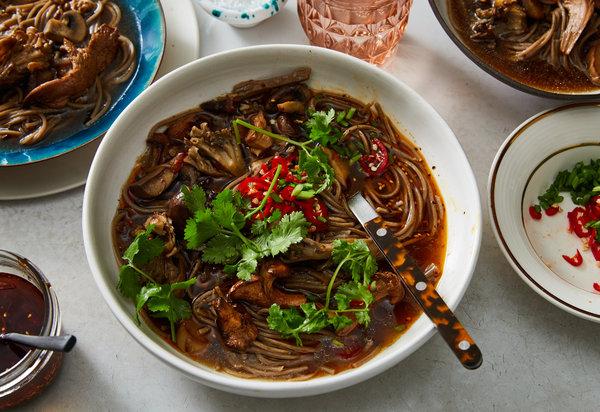Hi and welcome to Five Weeknight Dishes. Have you seen our special climate change issue? I’m so proud of it, especially this Q. and A., which answers all the questions we hear about how to cook, shop and eat in our changing world.
There are some real revelations in there. For starters, cheese has higher emissions than chicken and pork, on average. (One more time: Some cheese is worse for climate change than chicken and pork.) What you eat matters way more than the packaging it came in, or where it came from. And I can’t even on paper vs. plastic.
I wanted us to publish a project like this for a long time because, you know, I eat food. I also read the news, and cook, and every time I bought groceries I came up against the fact that I didn’t actually know what the best choices were, from a climate perspective. After a while, it drove me sort of crazy. What was I supposed to eat?
And so here we are: the information I wanted. I hope it’s as useful to you as it has been to me. (You can also take this quiz to measure the impact your own diet has on climate change.) I’ve got five completely delicious climate-friendly recipes for you below, and you can email me anytime at dearemily@nytimes.com.
Here are five dishes for the week:

CreditMichael Graydon & Nikole Herriott for The New York Times. Prop Stylist: Kalen Kaminski.
1. Spicy Noodle Soup With Mushrooms and Herbs
You guys, this recipe. It’s by Alison Roman, and it’s superb whether you make it with fancy mushrooms or cheap mushrooms, stock or water. I thought it was one of the best dishes I’d made in a long time. It also happens to be vegan, and it keeps well if you make extra. (Store the noodles separately from the broth.) Skip the chiles if you don’t like heat, or make them a garnish if others do.
View this recipe in your weekly plan.
_____
2. Farro With Salmon, Cucumber, Radicchio and Dill
This recipe cleverly steams the salmon right on top of the farro, which means it’s practically no work at all to both cook and clean up. The radicchio salad on top makes it a one-bowl meal — or, though it’s a different direction, you could do baby spinach to keep things simple. If you’re buying farmed salmon and optimizing for climate-friendliness, look for fish that is certified sustainable (this is not the same thing as organic). You could also check Seafood Watch for recommendations.
3. Green Shakshuka With Avocado and Lime
While there is no bad way to do eggs for dinner, this is an especially good one. You could increase the greens, if you wanted, maybe add some rice on the side and decrease the cheese, which isn’t necessary. Don’t skimp on the other toppings: You’ll want the full lime-chile-tortilla experience.
View this recipe in your weekly plan.
_____
I love this recipe and, because I always have a jar of tuna in the kitchen, I’ve iterated on it with whatever is around. (The avocado is nonnegotiable, though.) It is killer with good toast, and makes a great lightish dinner for two people. Here’s a shortcut way to pickle the red onions: Slice them, put them in a bowl and then submerge them in rice wine vinegar and lime juice, with a pinch of sugar sprinkled over them. Let sit at least 15 minutes, preferably longer. Eat. This is the condiment you need in your life.
View this recipe in your weekly plan.
_____
5. Takeout-Style Sesame Noodles
This is a cherished NYT Cooking classic, and while it’s great all on its own (and vegan too), it’s also an excellent vehicle for leftover shredded chicken or cubed tofu or fried eggs. Or do what my friends Jason and Siobhan do for their family and double the sauce, up the noodles a bit, and then shred carrots or slice zucchini to toss into the noodles. The sauce ties it all together.
View this recipe in your weekly plan.
Thanks! You’ve reached the end, but you can dive into archived newsletters here, or follow me on Instagram, or search 19,500 more recipes on NYT Cooking. (Subscribe here!) Follow NYT Cooking on Instagram, Facebook and Pinterest. All of the recipes above are in your weekly plan, and I’m dearemily@nytimes.com. Finally, if you have any problems with your account, email cookingcare@nytimes.com.




